
ACT Science Practice Test 42
Đề thi nằm trong bộ sưu tập: Tuyển Tập Bộ Đề Thi Đại Học Hoa Kỳ (ACT) - Có Đáp Án Chi Tiết
Số câu hỏi: 22 câuSố mã đề: 1 đềThời gian: 1 giờ
208,313 lượt xem 16,019 lượt làm bài
Xem trước nội dung:
Table 1 lists two genes found in Sesamum indicum (sesame), the possible alleles of each gene, and the possible genotypes for each gene.
Table 1

Table 2 lists various sesame genotypes and the phenotype associated with each genotype. Each gene affects only one of the phenotype traits listed.
Table 2
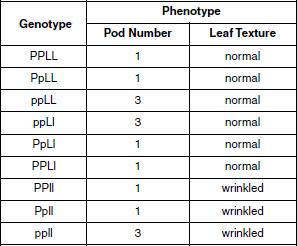
Table 3 lists four sesame plant crosses, the genotypes of the parents, and the percent of offspring that had each phenotype for the traits listed in Table 2. In each cross, each parent donated one allele to each offspring at each gene.
Table 3

Based on Table 2, which of the 2 genes affects leaf texture?
P
L
Neither
Both
Based on Table 2, a sesame plant with 2 recessive alleles for each of the 2 genes will have which of the following phenotypes?
1 pod and normal leaves
3 pods and normal leaves
3 pods and wrinkled leaves
1 pod and wrinkled leaves
Based on the information provided, all of the offspring of Cross 3 had 3 pods because each received:
allele p from its female parent and allele p from its male parent.
allele L from its female parent and allele l from its male parent.
allele l from its female parent and allele L from its male parent.
allele P from its female parent and allele P from its male parent.
In Cross 3, what percent of the offspring had genotype pp?
0%
25%
50%
100%
Based on the information provided, a sesame plant with 3 pods and normal leaves could have which of the following genotypes?
PPll
PPLL
ppll
ppLl
To determine the effect of ambient ultraviolet radiation (UVR) on the chlorophyll production, growth rate, and cell death of Antarctic phytoplankton, scientists conducted experiments on phytoplankton communities exposed to natural levels of solar radiation.
Experiments were conducted during three different periods of time. Experiment 1 took place February 1–6, Experiment 2 February 7–12, and Experiment 3 February 13–20. A meteorological station automatically recorded solar radiation for the duration of the study (see Figure 1).
The experiments involved sampling surface seawater, placing them in bottles submersed in incubators, and exposing them to either natural solar radiation (UVR) or radiation filtered to exclude ultraviolet radiation (PAR).
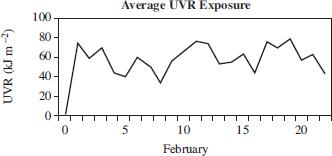
Figure 1
Every two days, duplicate samples were taken from each location to determine chlorophyll amounts and phytoplankton cell death (see Table 1 and Figure 2). Net population growth rates were calculated for diatoms and flagellates from the cell abundances obtained at the beginning and end of the experiments (see Figure 3).
Table 1
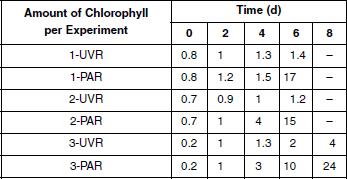
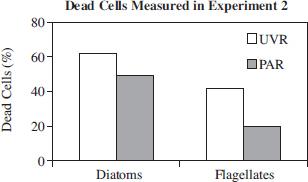
Figure 2

Figure 3
Based on the data in Table 1, how much chlorophyll was measured in Experiment 3 for the sample exposed to UVR after 4 days?
1
1.3
3
4
Based on the information presented in Table 1, UVR seems to have what effect on the amount of chlorophyll measured?
UVR seems to inhibit the production of chlorophyll.
UVR seems to stimulate the production of chlorophyll.
UVR seems to have no effect on the production of chlorophyll.
It cannot be determined what the effect of UVR is on chlorophyll.
According to the data shown in Figure 3, which cells showed the least growth in Experiment 3?
Diatoms shielded from UVR
Diatoms exposed to UVR
Flagellates shielded from UVR
Flagellates exposed to UVR
Based on the information presented in Table 1, if Experiment 1 had been continued for another 2 days, the amount of chlorophyll measured in the samples that were not exposed to UVR would most likely be closest to what amount?
0
17
3
36
Based on the results displayed in Figure 2, it can be assumed that ultraviolet radiation (UVR) has what effect on the life of the diatoms and flagellates found in phytoplankton?
The presence of UVR leads to fewer dead diatoms and more dead flagellates.
The presence of UVR leads to more dead diatoms and fewer dead flagellates.
The presence of UVR leads to fewer dead cells for both diatoms and flagellates.
The presence of UVR leads to more dead cells for both diatoms and flagellates.
Ecological indicators are used to assess the condition of the environment, to provide early warning signals of changes in the environment, or to diagnose the cause of environmental problems. Some important criteria for selecting an indicator include:
1. The indicator should provide an accurate picture of what it is supposed to indicate, such as “ecosystem health.”
2. The indicator should respond quickly to environmental changes.
3. The indicator should be easy to monitor.
4. The responses of the indicator in one or a few locations should indicate the state of the ecosystem in a larger area.
It has been suggested that seabirds are useful indicators. Two researchers discuss the effectiveness of using seabirds as indicators.
Researcher 1
Seabirds are valuable indicators because they are top predators in their ecosystem. Seabird populations and reproduction rates are regulated by prey abundance, and will therefore reflect environmentally induced changes in prey availability. The effects of reductions in prey resources, such as declining numbers of seabirds, are usually very rapid, due to the short food chain, which is another advantage.
A few species of small fishes are important species of the ecosystem, having a major effect on the ecosystem as a whole. Seabirds that eat mainly these key fish are good indicators of the ecosystem in general.
Additional demographic parameters that can easily be monitored in seabirds are population size, duration of foraging trips, and changes in body mass and offspring growth rate, all of which are useful environmental monitors.
Overall, seabirds are a cost-effective, useful, and meaningful indicator of environmental changes in ocean ecosystems.
Researcher 2
There are several reasons why seabirds may not be suitable as indicators of the impacts of environmental changes. First of all, not all marine ecosystems follow a top-down food chain. Some marine food webs are dynamic and can alternate between bottom-up and topdown. In addition, change in seabird numbers due to food scarcity usually has a lag of several months or even years. Because of this seabirds are not suitable as indicators of the food supply in all ecosystems.
In general, the effect of environmental change on seabird populations may take many years to become apparent. Its effect is complex and involves many physical and biological processes. This is a severe drawback to using seabirds as indicators. Another drawback is the handling effect. It is not fully understood what effect handling seabirds has on them. There is some evidence that bands placed on penguins to track them can reduce both breeding success and survival rates. With seabirds that are tagged and handled, it is difficult to be sure that observed effects are actually due to changes in the environment and not other factors.
The effect of environmental changes on seabirds is complex and it is not clear what the best way to monitor seabirds is. Therefore, seabirds are not a good choice for indicators.
Based on Researcher 1’s discussion, demographic factors that can be easily monitored in seabirds include all of the following EXCEPT:
population size.
changes in offspring growth rate.
mortality rates.
length of foraging trips.
Sardines are plentiful in Chiriqui Bay, and their presence affects the entire ecosystem of the bay. Kingfisher birds eat mostly sardines and because their numbers are declining, scientists are concerned about the environmental health of Chiriqui Bay. Is this concern consistent with the viewpoint of Researcher 1?
No, because Researcher 1 states that changes in the food chain are not adequate indicators of the environmental health of a body of water.
No, because Researcher 1 states that only changes in body mass and offspring growth rate are valuable indicators of environmental changes.
Yes, because Researcher 1 states that the effect of environmental changes on seabirds will be slow due to the short food chain in a marine ecosystem.
Yes, because Researcher 1 states that seabirds that consume key fish in an ecosystem are valuable indicators of the ecosystem in general.
Which researcher believes that handling seabirds may affect the validity of the results gathered by monitoring them?
Researcher 1, because that researcher states that changes in prey resources are very quick, and therefore results gathered will be valid.
Researcher 1, because that researcher states that overall, seabirds are a useful indicator of environmental changes.
Researcher 2, because that researcher states that placing bands on penguins has been shown to reduce their survival rates.
Researcher 2, because that researcher states that it is clear that handling seabirds will always reduce their breeding rates.
A study found that within two months of an oil spill in a bay, there was a drastic reduction in the number of small forage fish found in the water, and that the number of seabirds in the area was drastically reduced as well. Which researcher would most likely use this study to support his or her viewpoint?
Researcher 1, because it would demonstrate how quickly environmental changes impact prey resources and seabird behavior.
Researcher 1, because it would demonstrate how important seabirds are for the overall ecosystem.
Researcher 2, because it would demonstrate how quickly environmental changes impact prey resources and seabird behavior.
Researcher 2, because it would demonstrate how important seabirds are for the overall ecosystem.
Based on Researcher 2’s discussion, seabirds would not be effective indicators because they do not meet which criteria of a good indicator?
Point 1 only
Points 1 and 2 only
Points 1, 2, and 3 only
Points 2 and 3 only
Which of the following graphs is most consistent with Researcher 1’s view on the relationship between prey abundance and seabird population?




Researcher 2 cites all of the following as reasons why seabirds may not be suitable as indicators EXCEPT:
the impact of food scarcity on seabird numbers may not be apparent for several months or years.
it is not known how handling seabirds might impact them.
it is expensive to use seabirds as indicators.
it is uncertain how to best monitor seabirds.
Scientists used gas chromatography to analyze benzene concentrations in fuel vapors. The results of the analysis are displayed in Table 1.
Samples from four different brands of fuel were collected, with each brand offering both leaded and unleaded versions of fuel. A portion of each sample was analyzed for benzene concentration in the liquid, while the rest of the sample was placed in a vial and prepared for vapor analysis. Each vial was put into an oven, heated, and the gas chromatograph detected the concentrations of benzene in the vapor. Figure 1 displays the oven temperature during the experiment.
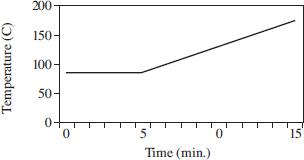
Figure 1
Table 1
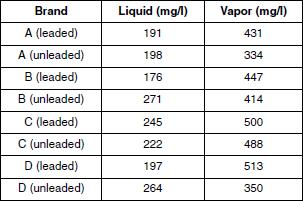
A gasohol is a fuel blended with certain alcohols such as ethanol or methanol. Two of the fuels tested in this experiment (brands C and D) were gasohols. Figure 2 shows the average concentrations of benzene found in the liquid and vapor form of the leaded and unleaded fuels tested. Figure 3 compares the average concentrations of benzene found in gasohols and regular unleaded fuels.
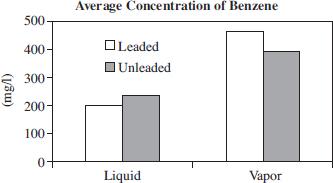
Figure 2
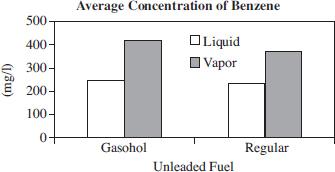
Figure 3
According to Figure 2, the average concentration of benzene found in the liquid form of leaded fuel was approximately:
200 mg/l.
240 mg/l.
480 mg/l.
400 mg/l.
Based on Figure 2, which type of fuel tested was found to contain the highest average concentration of benzene?
Liquid unleaded
Liquid leaded
Vapor leaded
Vapor unleaded
Suppose that during the experiment the samples of fuel had been kept in the oven for 20 minutes. Based on Figure 1, the temperature in the oven after 20 minutes would most likely have been:
less than 100°
between 100°C and 150°
between 150°C and 200°
greater than 200°
A scientist claimed that, in liquid form, a leaded fuel would emit more benzene than an unleaded fuel. Does the data in Table 1 support this claim?
Yes. For all fuel brands tested, the benzene levels were higher in the leaded fuel than in the unleaded fuel.
Yes. For all fuels tested, the amount of benzene found in the vapor form was higher than that found in the liquid form.
No. The amount of benzene found in the leaded fuel was only higher than the amount found in the unleaded fuel for one brand tested.
No. Only nongasohols emit more benzene in the leaded version of the fuel.
According to Figure 3, how did vaporizing the gasohol fuels affect the average concentration of benzene found in the fuel? In the gasohol fuels, the average concentration of benzene found in the liquid form of the gas was about:
two times the average concentration found in the vapor form.
one-half the average concentration found in the vapor form.
one-quarter the average concentration found in the vapor form.
the same as the average concentration found in the vapor form.
